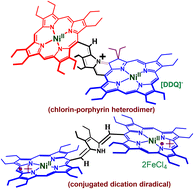Control of spin coupling through a redox-active bridge in a dinickel(ii) porphyrin dimer: step-wise oxidations enable isolations of a chlorin–porphyrin heterodimer and a dication diradical with a singlet ground state†
Abstract
A dinickel(II)porphyrin dimer has been used here in which the redox-active pyrrole-moiety, similar to the tryptophan residue in diheme enzymes such as MauG and bCcP, has been placed between two Ni(II)porphyrin centers connected via a flexible, but unconjugated methylene bridge. This arrangement provides a large physical separation between the two metal centers and thus displays almost no communication between them through the bridge. Upon treatment with DDQ as an oxidant, the dinickel(II) porphyrin dimer slowly gets converted into an indolizinium-fused chlorin–porphyrin heterodimer. However, oxidations of the dinickel(II) porphyrin dimer up to two oxidizing equivalents using oxidants such as AgSbF6 and FeCl3 resulted in the formation of a dication diradical complex. Interestingly, in order to stabilize such a highly oxidized dication diradical, two non-conjugated methylene spacers undergo facile 2e−/−2H+ oxidation to make the bridge fully π-conjugated for promoting through-bond communication. Through the oxidized and conjugated bridge, two porphyrin π-cation radicals display considerable communications leading to an efficient intramolecular spin coupling to form a singlet state. Interestingly, the redox-active nature of the bridge controls the electronic communication just by simple oxidation or reduction, and thereby, acts as a molecular switch for efficient magnetic relay.



 Please wait while we load your content...
Please wait while we load your content...